7. Parents’ choices of primary school
7. Parents’ choices of primary school
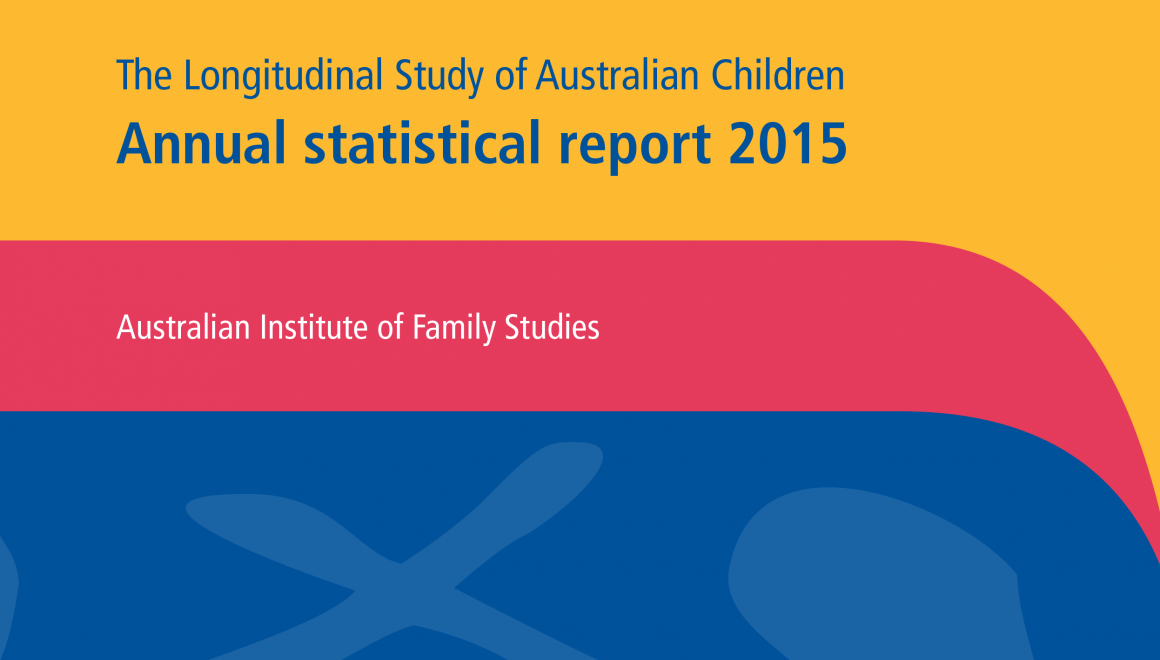
7.1 Introduction
For most of the twentieth century, it was quite uncommon for Australian parents to actively choose a school for their children. In the past, parents might have been concerned about whether a child might leave high school before completing year 12. Today, the question of “Which school is best for my child?” has become increasingly significant; and choosing a school is now a common and expected activity (Campbell, Proctor, & Sherington, 2009).
While government schools remain the major provider of primary school education in Australia, Catholic and independent primary schools have a significant market share. In 2014, 19% of primary school children attended a Catholic school and 12% went to an independent school (Australian Bureau of Statistics [ABS], 2015). For most parents, choosing a school for their child is a major decision which may require a good deal of research to learn about potential schools and their offerings. This decision is usually based on a variety of school attributes. Academic results, school location, the reputation of the school, the philosophical or religious focus of the school and the affordability of school fees have been shown to be the main factors affecting school choice in Australia (Goh & Dolincar, 2006). Other factors, including opportunities for the child to establish social networks; school and class size; whether the school is co-educational or single-sex; specific programs, subjects and extracurricular activities that are offered by the school; and whether the primary school is a “feeder school” for a high school with a good reputation are also important considerations for some parents (Campbell et al., 2009).
For many parents, the decision about which school their children will attend is made well before the time a child is enrolled in primary school. Families actively plan for the schooling of their children, and this planning and evaluation occurs both before and after enrolling their child in school for the first time. As some well-regarded independent schools have long waiting lists for enrolment, for some parents, anxiety about school choice can begin as early as the conception of a child (Campbell et al., 2009).
The decision about which school a child will attend may be further complicated by other factors; for example, waiting lists for popular schools and school zoning, whereby school enrolment is dictated by strict residential boundaries (Johnston, Lee, Shah, Shields, & Spinks, 2014). Many families think about the schooling of their children before buying or renting a house, with the suburbs with acceptable schools or easy transport accessibility often determining where the search for a home will occur. There is some anecdotal evidence that “buying an enrolment” in a government school with a good reputation is becoming an increasingly common strategy for parents of primary and secondary school-age children, with many highly regarded government schools enforcing residential zones to restrict enrolments to children who live within a limited distance of the school. However, given the high prices of homes in these areas, this option may be out of reach for many families, and therefore this strategy is likely to be most common among high-income families.
In an article in the Sydney Morning Herald, Bonnor (2014) suggested that parents really only have a choice about which school their child will attend if they can find money for fees or a house in the right suburb, and have access to information and networks. A study of the impact of school zones on housing values in the United States found that a one student-level standard deviation difference in a school’s mean test score was associated with a 10 percentage point difference in house value (Kane, Staiger, & Riegg, 2005). In Australia, Davidoff and Leigh (2007) investigated the relationship between housing prices and the quality of public schools in the Australian Capital Territory by comparing sale prices of homes on either side of high school attendance boundaries and found that a 5% increase in test scores (approximately one standard deviation) was associated with a 4% increase in house prices.
A survey conducted for the Independent Schools Council of Australia (ISCA) in 2008 found that, in choosing an independent school for their children, parents are influenced by a variety of factors, including religious affiliation, broad academic outcomes, quality teaching, a supportive, caring environment, the physical environment and facilities, the content of the curriculum, quality leadership and the range of extracurricular opportunities; but what parents wanted above all is for their children to have a well-rounded education with a strong emphasis on learning life skills. According to Ball (2003), the choice of a school is the choice of a “moral community” that reflects parents’ values, whereby parents can differentiate themselves from other parents who do not share their values and draw boundaries between different groups of parents. Using the 2001 Australian Census data to examine primary and secondary school choices, Mavisakalyan (2012) found that private school attendance among native-born Australians is higher in areas with a higher share of immigrant populations; while immigrants’ private school attendance is lower in localities where the share of their like-type immigrants is higher; and suggests the possibility that some (native-born and immigrant) parents are using private schools to segregate their children from unfamiliar cultures.
While most of the research about school choice, particularly for Australia, focuses on the determinants of high-school choice (e.g., Dearden, Ryan, & Sibieta, 2011; Kelley & Evans, 2004; Le & Miller, 2003; Potts, 2005) much less is known about the different factors that Australian parents consider when choosing their child’s first school. There is some limited evidence to show that the decision-making process when choosing a primary school differs according to socio-economic status, the child’s gender and academic ability, and other characteristics including whether the child already has a sibling attending school. For example, Bussell (2000) found that during the early stages of the decision-making process there are variations between different groups of parents; in particular, between first-time choosers and those with a child already at school and between parents from different socio-economic groups. A study based on a school choice program in the United States found that parents value proximity highly, and the preference attached to a school’s academic results increase with parental income and the student’s own academic ability (Hastings, Kane, & Staiger, 2005).
This chapter uses the LSAC data to examine the main factors associated with parents’ decisions about the type of primary school their child will attend. Both cohorts of LSAC data are used to explore the association between the sector (government, Catholic or independent) of school that a child attends at the age of 6–7 and a range of characteristics including household income, parents’ education, parents’ religion, region of residence and parents’ expectations about their child’s education. Using the MySchool data, which became publically available in 2008 and was matched to LSAC data for the first time in Wave 5, for children in the B cohort who changed schools between the age of 6–7 and 8–9, we are also able to examine parents’ reasons for changing schools and differences in the attributes (e.g., NAPLAN performance and disadvantage level) of the new school compared to the old school.
The key research questions explored in this chapter are:
- Does parents’ choice of primary school sector differ according to characteristics such as parents’ education, household income and parents’ aspirations for their child?
- Do parents’ reasons for changing schools differ according to characteristics of the child and the household?
- How do other aspects of school quality influence parents’ choice of school?
The chapter is structured as follows. A description of the data and methods used is given first. The first analytical section of the chapter focuses on the sector of the school attended (government, Catholic or independent). The second section examines parents’ reasons for choosing the school that their child attends, and differences in these reasons according to characteristics of the child and the household. The final analytical section looks at reasons for changing schools, and differences in these reasons according to the type of school change, that is change in sector and change in school quality, measured by school Index of Community Socio-Educational Advantage (ICSEA) score and school academic performance. This is followed by a discussion and conclusion.
7.2 Data and methodology
Data from both cohorts of LSAC are used in this chapter, to provide insights on how parents make the decision about the primary school that their child will attend. For children in the B cohort, data from Waves 3, 4 and 5 are used; and for the K cohort, data from Waves 2, 3 and 4 are used.
For the majority of children in the LSAC study, age 6–7 was the first time we could examine school choice, and so it is school choice at this age that is the main focus of this chapter, with some additional analyses of later school moves. The majority of children were in year 1 at this age, and we focus only on these children, to concentrate on school choice at a particular stage in children’s school life. The percentage of children attending government, Catholic and independent schools in year 1 was quite similar for children in the B and K cohorts of LSAC. Around two-thirds of children were attending a government school, just over 20% were attending a Catholic school and the remaining 10–11% went to an independent school.
Two key sets of information are used in this chapter: ACARA (MySchool data) and parent reported information about their reasons for choosing the primary school their child attends, and the reasons their child changed schools (if their child had changed schools since starting primary school).
School ICSEA and NAPLAN information come from MySchool data, which are matched to LSAC for 2008 onwards.1 These data provide detailed information about all Australian schools, including their academic performance and the level of socio-economic advantage or disadvantage of the school population. The data became publically available for the first time in 2010, when the majority of the B cohort children were in Year 1. It was not appropriate to examine whether MySchool data influenced parents’ choice of primary school, as it was not available to parents when they were making these decisions. However, for children in the B cohort who changed schools between 2010 and 2012, we can examine school transitions in terms of changes in school sector, school performance and school advantage level, as well as the reasons for changing school. MySchool data are described further below.
School advantage is measured using the Index of Community Socio-Educational Advantage (ICSEA). This measure, which is designed to represent the level of educational advantage for each school, is constructed from two alternative data sources: information relating to parent occupation, school education, non-school education and language background obtained from student enrolment records (direct data); and Australian Bureau of Statistics (ABS) census data (indirect data) (ACARA, 2012). Every school has an ICSEA value on a scale that has a median of 1000 and a standard deviation of 100. ICSEA values range from around 500 (representing extremely educationally disadvantaged backgrounds) to about 1300 (representing schools with students from very educationally advantaged backgrounds) (ACARA, 2012).
A measure of school NAPLAN performance is created based on the year 3 and year 5 NAPLAN scores of the school in the year that the child started that school. The performance of the school is measured by summing the school average scores in all five NAPLAN domains (Reading, Numeracy, Spelling, Grammar and Writing) for year 3 and year 5.2
Methodology
This chapter provides descriptive evidence about the school sector that children attend at age 6–7, parents’ reasons for their choice of school, reasons for changing schools and the types of transitions between schools (i.e., changes between school sector and differences in the academic performance and advantage level of the new school compared to the previous school). Where data for both LSAC cohorts are available and there are no substantive differences in the results for the B and K cohorts, results for the pooled sample are presented.
To examine factors that might explain variation in school sector, characteristics of the child and their household in the previous wave were used, when the child was aged 4–5. Differences in school sector at age 6–7, according to socio-economic characteristics (equivalised parental income, parents’ education and occupation) and parents’ religion are examined.3 Further, school choice was examined by parents’ expectations about their child’s post-school education. This was asked for the first time in LSAC when the children were aged 6–7. However, it is assumed that for most parents, their expectations would not have changed dramatically in the two years prior to their child starting primary school.
Parents of children in the K cohort (but not the B cohort) were also asked about their main reason for their choice of primary school when their child was aged 6–7. Differences in these responses, according to the characteristics of the parents and the child are examined.
Parents of children who had changed schools since the last interview were asked about their main reason for changing schools.4 For children in both cohorts, differences in the reason for changing schools are examined according to the change in school sector, as well as some characteristics of the parents and the child. For children in the B cohort, we are able to use MySchool data to examine differences in reasons for changing schools, depending on the academic performance and level of disadvantage of the previous school and the current school.
7.3 Factors associated with school sector choice
The decision about which school to send a child to is a complex one, and it is likely that many factors work together in influencing that decision. For example, socio-economic factors are likely to be related to parents’ expectations about their child’s education; and both these factors are likely to influence the decision about the type of school that a child attends. In this section we use data from both LSAC cohorts to examine differences in school sector choice (government, Catholic or independent) according to a subset of factors that have been shown to influence school choice, namely parents’ religion, socio-economic factors (parental income, parents’ education and occupation) and parental expectations about their child’s post-school education).5
Parents’ religion and choice of school sector
In the past, Catholic schools were primarily for practicing Catholics and few non-Catholics considered enrolling their children, but now, most Catholic schools are open to non-Catholic as well as Catholic enrolments (Preston, 2003). Most non-government (i.e., Catholic or independent) schools in Australia have a formal Christian religious affiliation; and this restricts the choices available for parents who prefer a secular or non-Christian education for their children. Campbell, Proctor, and Sherington (2009) found that some parents expected religiously affiliated schools to demonstrate active religiosity, while others saw them as a haven for their children from unsatisfactory government schools.
Figure 7.1 shows that many Catholic families remain loyal to Catholic schools, with half of the children whose mother reported being Catholic attending a Catholic school. There is also a considerable amount of variation in the percentage of children attending independent schools, with the percentage of children attending independent schools significantly higher among those whose mother had either a Christian denomination other than Catholic or a non-Christian religion.
Figure 7.1: Year 1 school sector at age 6–7, by mother’s religion

Note: Chi-square tests used to compare proportions in each school sector indicate significant differences according to mother’s religion (p < .001).
Source: LSAC B cohort, Waves 3 and 4; and K cohort, Waves 1 and 2 (n = 6,261)
While the percentage of children attending a Catholic school was highest when the mother was Catholic, a significant proportion of children whose mother was Catholic attended government schools, but only 6% attended an independent school. This may be related to factors such as socio-economic status, and also the religion of the father. Further analysis of these associations revealed considerable differences in the percentage of children attending Catholic schools, depending on whether they were living in single-parent or two-parent households (Figure 7.2). For example, among children whose mother is Catholic, 52% of children in two-parent households and 32% of children in single-mother households attended a Catholic school. A report by the National Catholic Education Commission (2004) suggests that the difference in enrolment patterns between single- and two-parent families may be due to a number of reasons, including the capacity to pay for a Catholic education for single-parent families.
Figure 7.2: Year 1 school sector at age 6–7, by parents’ religion and household structure
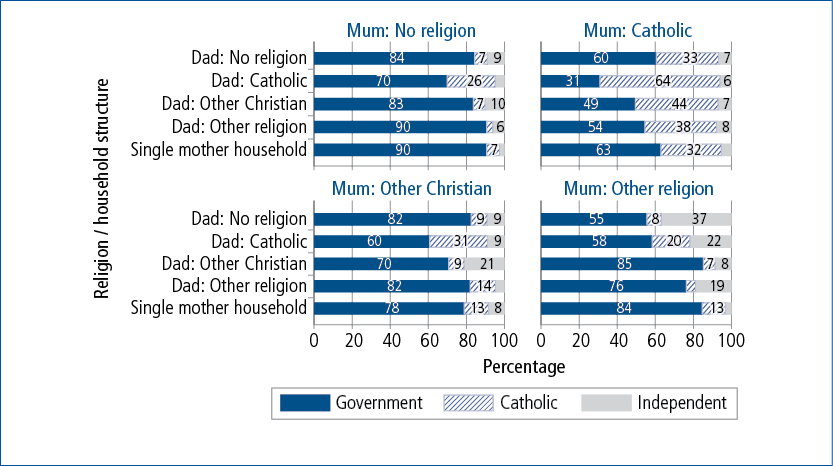
Note: Chi-square tests used to compare proportions in each school sector indicate significant differences according to father’s religion (p < .001).
Source: LSAC B cohort, Waves 3 and 4; and K cohort, Waves 1 and 2. Sample restricted to children in Year 1 at age 6–7 (n = 6,183).
Among children who were living in a two-parent household, 64% of children with two Catholic parents attend a Catholic school. It appears that when making the decision about school sector, the mother’s religion has a stronger influence than the father’s. For example, 38% of children whose mother was Catholic and whose father had a non-Christian religion attended a Catholic school, compared to 20% of children whose father was Catholic and whose mother had a non-Christian religion.
Still, a relatively large proportion of children whose mother is not Catholic also attend Catholic schools. Around 8% of children with no resident parent reporting being Catholic attended a Catholic school. This is likely to be because of a perceived higher quality of Catholic schools compared to government schools, and at a lower cost than other independent schools (Sander, 2001). For some non-Catholic families, this is likely to make a Catholic school an appealing alternative to the local government school and higher-cost independent schools.
Socio-economic factors and choice of school sector
While the conventional view of the basis for school sector choice may be that it is a matter of income and social class, there is some evidence to suggest that factors such as parental education and occupation, and values and attitudes are also important; and that for families choosing non-government schools, school community and culture are more important than social class and wealth (ISCA, 2008).
This section explores socio-economic factors, first looking at income, then parents’ education and occupation. Figure 7.3 compares the school sector that children were attending at age 6–7 according to the quartile of equivalised parental income when the child was aged 4–5. The percentage of children attending a government school is highest among those with parental income in the lowest quartile (76%) and lowest among children whose combined parental income is in the highest quartile (56%). Given the higher cost of school fees in many independent schools, it is not surprising that the percentage of children attending these schools was highest among children whose parents’ combined income was in the highest quartile. Estimates by the Australian Scholarships Group (ASG, 2015), providing a breakdown of the average annual costs for a child attending 6 years of primary schooling, suggest that the total cost for a child to attend an independent primary school, starting in 2015, would be around $97,000, compared to $44,000 for a Catholic school and $19,000 for a government school.6
Figure 7.3: Year 1 school sector at age 6–7, by quartile of combined parental income at age 4-5
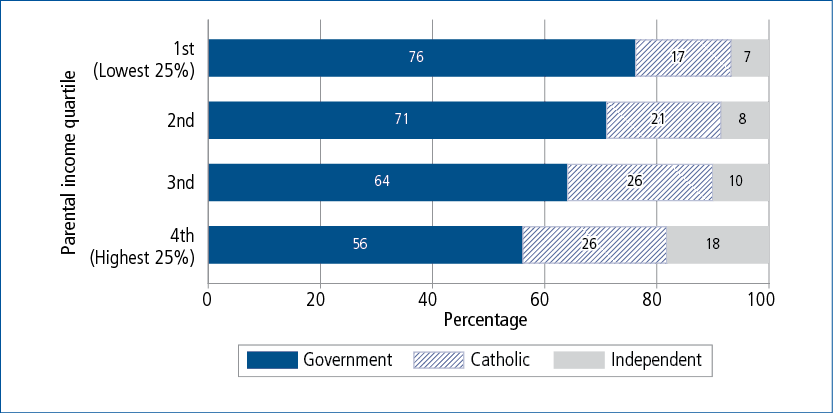
Note: Chi-square tests used to compare proportions in each school sector indicate significant differences according to quartile of parental income (p < .001).
Source: LSAC B cohort, Waves 3 and 4; and K cohort, Waves 1 and 2 (n = 6,295)
While differences in the percentage of children attending independent schools were quite small in the first, second and third income quartiles, for children whose parental income was in the highest quartile, the percentage who attended an independent school was almost double that of children with parental income in the third quartile. However, there was no difference in the percentage of children attending Catholic schools in the top two quartiles of equivalised parental income; and even in the lowest two income quartiles, the percentage of children attending Catholic schools is more than double that of children attending independent schools.
Parents’ education level is also associated with differences in the type of school that a child attends (Figure 7.4). Among children whose mother had a degree qualification, 42% attended a non-government school, compared to 25% of children whose mother did not complete year 12. This difference was mainly due to the difference in the percentage of children attending independent schools, with only 6% of children whose mother did not complete year 12 attending an independent school, compared to 16% of children whose mother had a degree qualification.
Figure 7.4: Year 1 school sector at age 6–7, by mother’s highest level of education
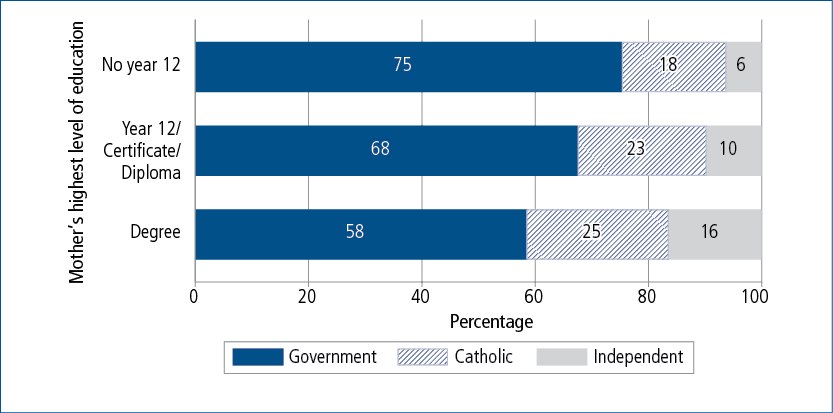
Notes: Chi-square tests used to compare proportions in each school sector indicate significant differences according to mother’s education (p < .001). Degree category includes postgraduate qualifications.
Source: LSAC B cohort, Waves 3 and 4; and K cohort, Waves 1 and 2 (n = 6,268)
The education level of the child’s father is also an important factor. Figure 7.5 shows that among children in two-parent households, the percentage of children attending a government school was lowest among those whose father had a degree qualification. The influence of the father’s education on school sector choice appears to be weaker among children whose mother had a post-school qualification. For example, among children whose mother had a degree, the percentage of children attending a government school was around 60%, regardless of the father’s education level. However, among children whose mother did not have a post-school qualification, the percentage of children attending a government school ranged from 62% for those whose father had a degree to 74% among those whose father did not complete year 12.
Figure 7.5: Year 1 school sector at age 6–7, by parents’ education
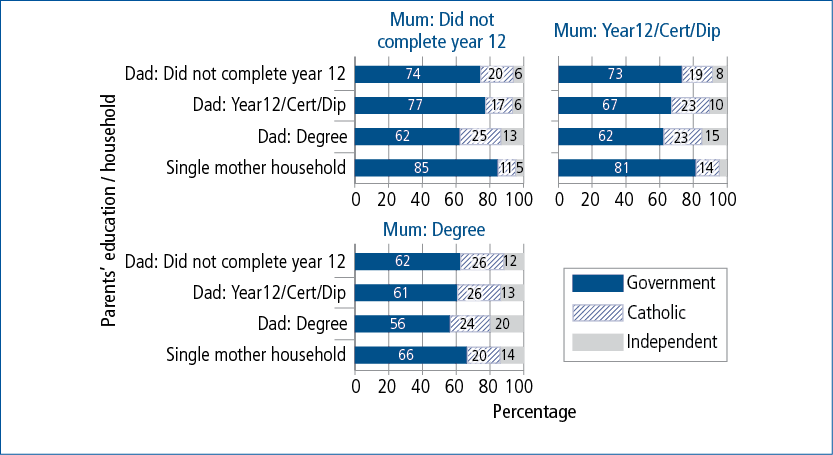
Notes: Chi-square tests used to compare proportions in each school sector indicate significant differences according to father’s education (p < .001). Degree category includes undergraduate and postgraduate qualifications.
Source: LSAC B cohort, Waves 3 and 4; and K cohort, Waves 1 and 2 (n = 6,175)
There is some evidence showing that parents’ decisions about school choice differ according to their occupation. In a survey of parents of secondary school students in Australia, Campbell, Proctor, and Sherington (2009) found that academic quality was more important for parents with professional and associate professional occupations; and concluded that these differences were largely due to family financial resources. However, it is important to keep in mind that there is a strong association between parental occupation and education, with parents in professional and associate professional occupations more likely to also have higher levels of education. Figure 7.6 compares the percentage of children in each school sector, according to their mother’s occupation. Where there was no father living in the child’s primary residence, we have labelled the category “single mother household” for comparison with the different levels of paternal education.
Figure 7.6: Year 1 school sector at age 6–7, by mother’s occupation
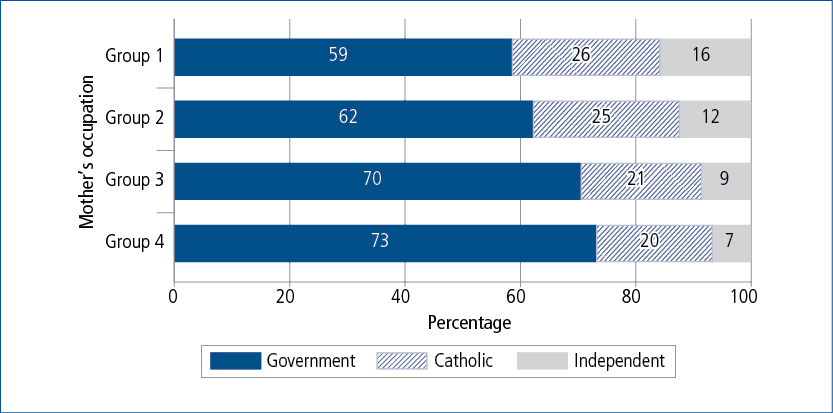
Notes: Chi-square tests used to compare proportions in each school sector indicate significant differences according to mother’s occupation (p < .001). For mothers who were not employed at the time of interview, most recent occupation is used. Group 1 = Managers, administrators and professionals; Group 2 = Associate professionals, advanced clerical and service workers; Group 3 = Intermediate and elementary clerical sales and service workers; Group 4 = Tradespersons, production and transport workers and labourers.
Source: LSAC B cohort, Waves 3 and 4; and K cohort, Waves 1 and 2 (n = 6,100)
The percentage of children attending Catholic schools was quite similar across mother’s occupation categories. However, the percentage of children in independent schools ranged from 7% of those whose mothers worked as tradespersons, production and transport workers or labourers to 16% of children whose mothers were managers or professionals.
Figure 7.7 shows that for children who were living in two-parent households, differences in the percentage of children attending Catholic school depending on their parents’ occupation were relatively small. However, the percentage of children attending independent schools was considerably higher among children whose father’s occupation was in either group 1 or group 2 (managers, administrators, professionals, associate professionals, advanced clerical and service workers). Among children in single-parent households, there was a considerable amount of variation in school sector by mother’s occupation group, with a much larger proportion of children whose mothers worked in managerial or professional roles attending non-government schools. Presumably this difference is, to some extent, due to differences in mother’s income, and hence capacity to pay for a non-government school, depending on their occupation.
Figure 7.7: Year 1 school sector at age 6–7, by parents’ occupation
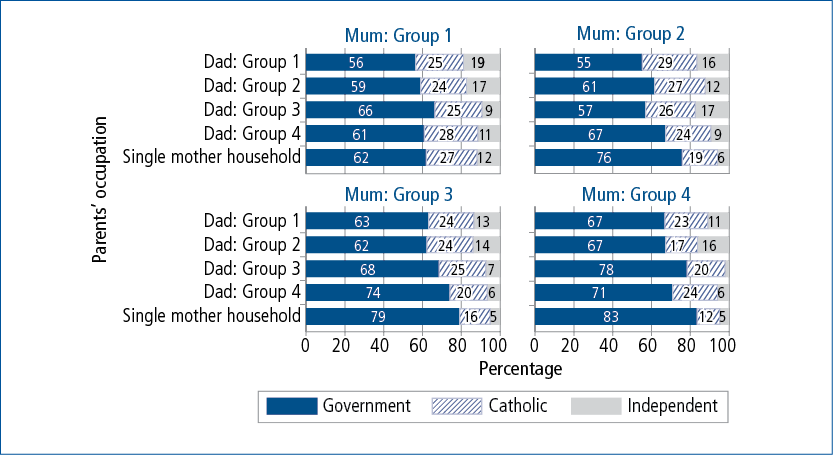
Notes: Chi-square tests used to compare proportions in each school sector indicate significant differences according to father’s occupation (p < .001). For parents who were not employed at the time of interview, most recent occupation is used. Group 1 = Managers, administrators and professionals; Group 2 = Associate professionals, advanced clerical and service workers; Group 3 = Intermediate and elementary clerical sales and service workers; Group 4 = Tradespersons, production and transport workers and labourers.
Source: LSAC B cohort, Waves 3 and 4; and K cohort, Waves 1 and 2 (n = 6,077)
Parents’ educational expectations and choice of school sector
Parents’ decisions about which primary school their child will attend are also likely to be associated with their aspirations for their child’s education. Previous studies have shown a strong link between parental expectations and later educational attainment; and given that the question about educational expectations was asked after the child had already started primary school, these expectations are likely to be related to the child’s ability before starting school, as well as the child’s progress in their schooling so far (e.g., Gregory & Huang, 2013). When children were aged 6–7, the child’s main carer (in most cases the mother) was asked how far they think their child would go with their schooling. Figure 7.8 shows the relationship between parental expectations and school sector choice.
Figure 7.8: Year 1 school sector at age 6–7, by parents’ educational expectations for their child
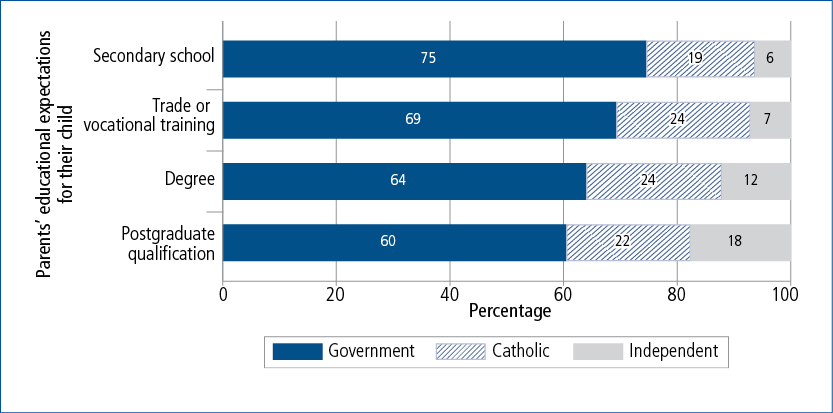
Notes: Chi-square tests used to compare proportions in each school sector indicate significant differences according to parental expectations (p < .001). 109 observations for children whose parents did not expect them to complete secondary school were included in the secondary school category.
Source: LSAC B cohort, Waves 3 and 4; and K cohort, Waves 1 and 2 (n = 6,130)
While the differences in the percentage of children attending Catholic school according to parents’ expectations were not large, there were substantial differences in the percentage of children attending independent schools depending on parents’ expectations about their post-school education, with only 6% of children whose parents expected them to go no further than secondary school attending an independent school, compared to 18% of children whose parents expected them to obtain a postgraduate qualification.
In summary, the analysis in this section has shown that there are a variety of factors associated with the decision about which primary school a child will attend, including parents’ religious affiliation, socio-economic factors, and parents’ expectations about their child’s post-school education. However, it is important to note that while the bivariate analysis section has shown a statistical association between many of these factors, we are unable to draw any conclusions about the causal influences of these factors on school choice, as other characteristics have not been controlled for.
7.4 Parents’ reasons for school choice
Several studies have shown that academic outcomes are not the only criteria for school choice, and that parents rank aspects such as values and discipline more highly. Buckingham (2015) suggested that few parents choose a school for their child based on the sector alone—the decision is based on the individual merits of the schools available to them, and parents make judgements about what they believe is best for their child, based on their own priorities. Proctor (2011) found that parents, particularly mothers, did a considerable amount of research before making the decision about their child’s school, gathering information about schools and also seeking out the advice of friends and family. She found that when choosing a school for their child, parents tended to trust their “gut feeling” or their friends’ anecdotes as much as anything else. Parents of children in the K cohort (age 6–7 in 2006) were asked what was the most important reason influencing their choice of the child’s school.7 Table 7.1 compares parents’ reasons for choosing a primary school, according to the school sector chosen.
Overall the most commonly cited reasons were:
- convenience for the family;
- other family members attending, or having previously attended, the school;
- academic reasons; and
- religious reasons.
However, these reasons varied significantly according to school sector.
- Among children attending a government school, the most common reasons for the parents’ choice of school was convenience for the family, followed by family reasons (i.e., other family members either currently attending or having previously attended that school).8
- As one would expect, for children who attended a Catholic school, the religious values of the school were the most common reason for choosing the school. However, less than 40% of parents of children in Catholic schools said that religious values were the most important reason for choosing the school, with just over 20% of parents saying that the most important reason for their choice of school was academic reasons, and 19% saying that they chose the school because a family member either was attending or had attended that school.9
- For children attending an independent school, academic reasons were the most common reason for the parents’ choice, followed by the religious values of the school.
The previous section of this chapter has shown that the school sector chosen by the parents varies considerably depending on parents’ religions, and to a lesser extent with the socio-economic characteristics of the child’s parents. Figures 7.9 to 7.12 show that parents’ reasons for school choice also vary according to these characteristics.
In Figure 7.9, parents’ reasons for choosing a school are compared, according to the mother’s religion:
- Compared to mothers who reported having no religion or a Christian denomination, mothers with non-Christian religions more commonly said that they chose a government school for convenience and less commonly reported choosing a government school for family reasons.
- Almost half of Catholic mothers reported choosing a Catholic school for religious reasons, while a similar proportion of those with no religion who made the same choice said they did so on academic grounds.
- Among parents whose children attended an independent school, 55% of mothers who reported having no religion said that they chose the school for academic reasons, while 31% of mothers with a Christian denomination other than Catholic and 39% of mothers with a non-Christian religion reported choosing an independent school for religious reasons.
Figure 7.9: Reasons for school choice, by school sector and mother’s religion
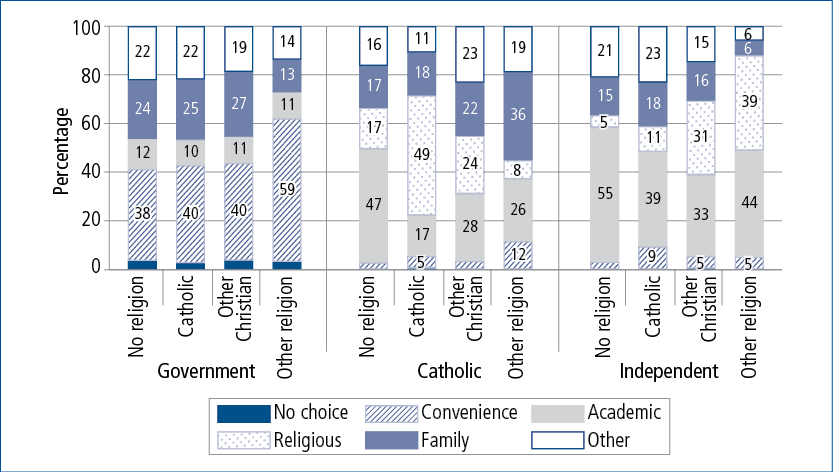
Note: Percentages may not total exactly 100.0% due to rounding.
Source: LSAC K cohort, Wave 2. Sample is restricted to children who were in year 1 in Wave 2 (n = 3,070).
In Figure 7.10, parents’ reasons for choosing a school are compared, by quartile of parental income:
- Of those parents who chose a government school, there was little variation in reasons for school choice across the top three income quartiles. The percentage who said they chose the school because of convenience was highest among those in the lowest quartile of household income. A slightly lower percentage of parents in the lowest quartile cited academic reasons.
- Among parents of children who attended a Catholic school, choosing a school for its religious values was more common among parents in the upper half of the income distribution.
- Parents commonly chose independent schools for academic reasons. With more parents in the lowest income quartile saying academic reasons were their highest priority (42%), rather than religious values (34%). However, among those in the second income quartile, choosing a school for religious reasons (37%) was more common than choosing a school for academic reasons (26%); and in the highest quartile, only 18% of parents reported choosing an independent school for religious reasons.
Figure 7.10: Reasons for school choice, by school sector and quartile of combined parental income
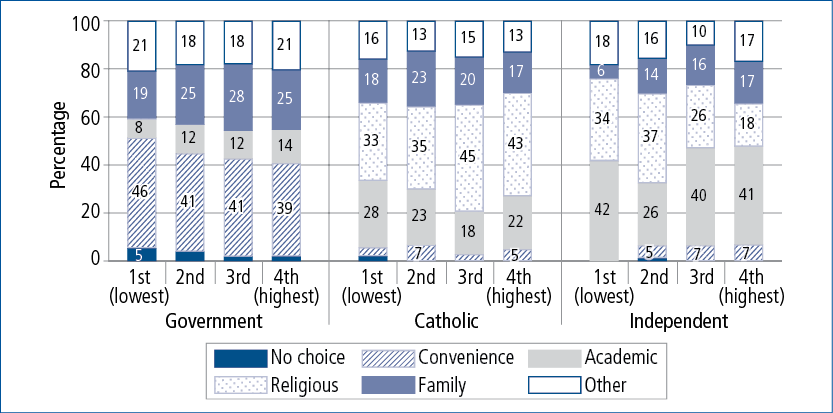
Notes: Percentages may not total exactly 100.0% due to rounding.
Source: LSAC K cohort, Wave 2. Sample is restricted to children who were in year 1 in Wave 2 (n = 3,091).
Figure 7.11 shows that:
- Among children who attended a government school, the percentage of parents who chose the school because of convenience was around 40%, regardless of the mother’s education. However, the percentage of parents who chose a government school for academic reasons was significantly higher among children whose mother had a degree qualification.
- The percentage of parents who chose a Catholic school for its religious values increased substantially with the mother’s education level.
- Among children who were attending an independent school, the percentage of parents who chose the school for religious reasons was significantly higher in households where the mother had not completed high school; with parents in this group less likely to report having chosen a school for academic reasons.
Figure 7.11: Reasons for school choice, by school sector and mother’s highest level of education
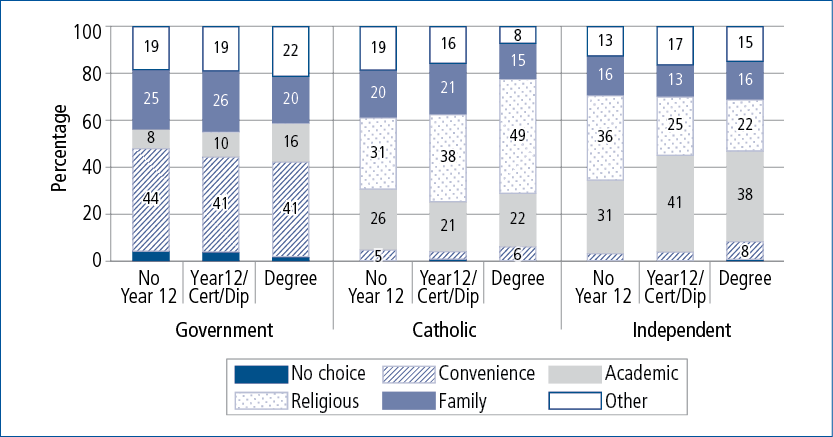
Notes: Estimates not reliable for mothers who had not completed year 12 whose children were attending an independent school. Percentages may not total exactly 100.0% due to rounding.
Source: LSAC K cohort, Wave 2. Sample is restricted to children who were in year 1 in Wave 2 (n = 3,072).
In terms of parental aspirations for their child’s education, Figure 7.12 shows that:
- Among children who attended a government school, the percentage of parents who said that they made their school choice for academic reasons was highest among those who expected their child to complete a university degree.
- While the percentage of parents who reported choosing a Catholic school for religious reasons increased with parental expectations about their child’s education, the percentage of parents who reported choosing a Catholic school for academic reasons was still highest among those who expected their child would complete a degree qualification.
- Among children who were attending an independent school, parents who expected their child to complete a postgraduate qualification were much more likely to say that they chose the school for academic reasons, and less likely to say they chose the school for religious reasons.
Figure 7.12: Reasons for school choice, by school sector and quartile of parents’ expected level of education for their child
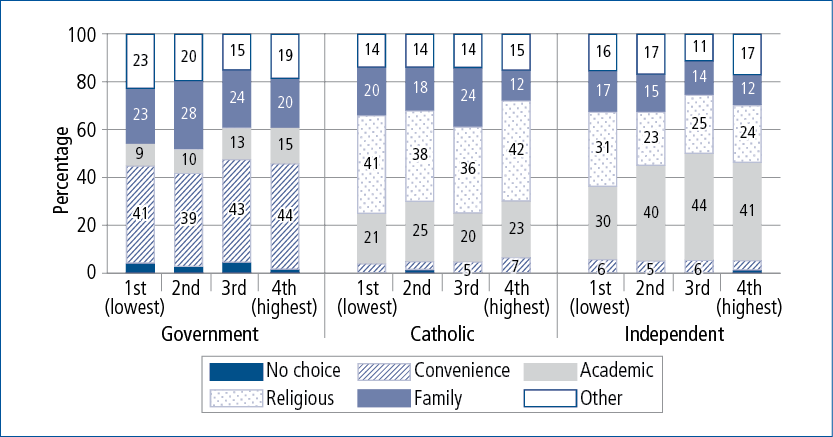
Notes: Estimates not reliable for mothers with expectations of secondary school or trade qualifications whose children were attending an independent school. Percentages may not total exactly 100.0% due to rounding.
Source: LSAC K cohort, Wave 2. Sample is restricted to children who were in year 1 in Wave 2 (n = 3,011).
In summary, for many parents, the decision about which primary school their child will attend is made with academic reasons as one of the main considerations. However, there are many other attributes that are also important in this decision. For parents who choose a Catholic or an independent school, the religious values of the school are an important consideration. Others make the choice about primary school simply for convenience, or for family reasons.
7.5 Reasons for changing schools
In 2010, MySchool data became publically available, providing parents with information about every school in Australia, including the school NAPLAN performance since 2008 and the school ICSEA score, which is a measure of the level of advantage or disadvantage of the school population. In this section, we look at parents’ reasons for changing schools, for children who changed schools between the ages of 6–7 and 8–9; and for children in the B cohort, we use the matched MySchool data to examine the differences in the performance and advantage levels of their current school and their previous school.
Around 16% of children who were in year 1 at age 6–7 had changed schools by age 8–9 (17% in the B cohort and 15% in the K cohort). Parents of children who had changed schools since the previous wave of LSAC were asked for the main reason their child had changed schools. For over 50% of children, the main reason that parents gave for changing schools was because of a residential move, as shown in Table 7.2. However, it is likely that some families made a residential move in order to live in what they perceived to be a better area, with better schools (and better learning opportunities) a flow-on effect from this decision. Therefore, there may be some overlap between these two reasons for changing schools.
The most common type of transition, in terms of school sector, was a change from one government school to another. Of those children who changed schools between ages 6–7 and 8–9, almost 60% had moved from one government school to another; around 10% had moved from a government school to an independent school, 7% moved from a Catholic school to an independent school, 7% had moved from one Catholic school to another and 5% had moved from one independent school to another.10
Table 7.3 shows the changes in school sector for those children who changed schools. Among children who had left a government school, the majority had moved to another government school, rather than a Catholic or independent school. However, among children who left a Catholic or independent school, changing school sector was more common, with over 40% of children who left a Catholic school moving to a government school. Among children who were attending an independent school at age 6–7 and had subsequently changed schools, only 38% of children in the B cohort and 56% of children in the K cohort had moved to another independent school.
There were some differences in the reasons that parents gave for changing their child’s school, depending on the type of transition made. For example, among children who had moved from one government school to another, or from one Catholic school to another, the most common reason for the change was because of a residential move. However, children who had moved from one independent school to another, or from a government to a non-government school, the most common reason given for the change in school was learning opportunities.11
Given that the majority of parents reported that their child changed schools because of a residential move, it is not surprising that there are no significant differences in reasons for changing schools, depending on parental education, parents’ religion or expectations about the child’s education. There were small but statistically significant differences in reasons for changing schools, depending on the quartile of parental income. Compared to children in the lowest quartile of parental income, children in the highest quartile of parental income were less likely to have changed schools because of a residential move, and more likely to have changed schools for better academic or learning opportunities.
For children in the B cohort who changed schools between 2010 and 2012, we are able to compare the level of school performance and school advantage of their current school with that of the school they were attending at age 6–7. Of those children who changed schools, a larger proportion moved out of low ICSEA (more disadvantaged) schools than high ICSEA schools. More specifically, 30% of children who changed schools left a school in the lowest ICSEA quartile; while only 18% of those who changed schools left a school in the highest ICSEA quartile.
Of those children in the B cohort who changed schools between 2010 and 2012, just over half (51%) had moved to a school with a similar ICSEA score to that of their previous school, 26% had moved to a more advantaged school and the remaining 23% had moved to a more disadvantaged school. Differences in the ICSEA score of the current and the previous school are likely to depend, at least to some extent, on the reason that the child changed schools. In Table 7.4, changes in school ICSEA according to the main reason for changing schools are presented.
Of those children who changed schools because of a residential move, just over a quarter had changed to a lower ICSEA school and almost 30% had moved to a higher ICSEA school. However, among those who changed schools for better learning opportunities, the majority had moved to a school with a similar level of advantage to that of their previous school.12 This result suggests that parents’ opinions about the learning opportunities provided by primary schools are not necessarily associated with the level of advantage or disadvantage of the school population.
Turning now to changes in school performance, the percentage of students moving out of low performing schools was higher than that of those leaving higher performing schools, with around 20% of children who were attending schools in the lower half of the NAPLAN distribution changing schools, compared to approximately 13% of those who were attending a school in the top half of the school NAPLAN distribution. In Table 7.5, changes in school performance, according to the main reason for changing schools are presented.
Of those children who changed schools for better learning opportunities, almost 60% had moved to a school with an average NAPLAN score at least half a standard deviation higher than that of their previous school. However, among those who changed schools because of a residential move, only 44% had moved to a higher performing school, while almost 30% had moved to a school with a lower level of academic performance.13 While these figures suggest that a large percentage of children who changed schools had moved to a higher performing school, it is important to remember that the number of children who actually changed schools is relatively small. In terms of the national population, this equates to an estimated 3,500 children who were aged 6–7 in 2010 changing schools by 2012 because of better learning opportunities and moving to a higher performing school. In other words, it does not appear that the availability of MySchool data has resulted in a large number of parents moving their children to a higher-performing school.
While the first NAPLAN tests were taken in May 2008, school performance data were not made publically available until the launch of the MySchool website in January 2010. Therefore, parents who made the decision to change their child’s school between 2008 and 2010 would have made this decision based on considerations other than school NAPLAN performance. Although the figures in Tables 7.5 and 7.6 are not directly comparable due to differences in the age of the children at the time they changed schools, they do provide some insight into transitions between lower and higher performing schools before and after the availability of MySchool data.
Among children in the K cohort who had changed schools between age 8–9 (in 2008) and age 10–11 (in 2010), 47% had changed schools primarily because of a residential move, 28% of parents reported that their child had changed schools for better learning opportunities, and the remaining 25% said they had changed schools for other reasons, including convenience. Among those who reported changing schools for better learning opportunities, more than half (54%) had moved to a higher performing school. However, among those who changed schools because of a residential move, only 40% had moved to a higher performing school; and 21% had moved to a school with a lower level of academic performance. These figures suggest that parents who moved their child to a different school for better educational opportunities were able to make a reasonable assessment of the quality of the learning opportunities of a particular school based on evidence other than school NAPLAN scores.
Table 7.6 shows that among children who changed schools, most moved to a school with an ICSEA score similar to that of their previous school. Differences in NAPLAN performance of current and previous schools were more substantial, with a large proportion (42%) of children who changed schools moving to a higher performing school, even if their parents reported changing schools for reasons other than academic ones. For some, moving to a better school may be simply a flow-on effect from upgrading houses and moving to a better area; but it is reasonable to presume that when making a residential move, parents will consider the quality of nearby schools, including their academic performance, even if it is not their main reason for moving house. Still, it cannot be concluded that the availability of MySchool data has resulted in a dramatic shift of students into higher performing schools. National population estimates indicate that of the 188,000 students who were in year 1 in 2010, around 12,000 (6.5%) had moved to a higher performing school by 2012.The majority of the parents of children who had moved to a higher performing school said that the main reason for changing schools was because of a residential move.
7.6 Summary and discussion
The analysis in this chapter shows that parents’ choice of primary school is associated with a variety of parental characteristics. Parents’ religion and socio-economic status and parental expectations about their child’s education are all significantly associated with the school sector that parents choose.
Parents’ reported reasons for changing schools also varied with religion, socio-economic characteristics and parents’ expectations about post-school education. For many parents, the decision about which primary school their child will attend is made with academic reasons as the main consideration. However, there are many other attributes that are also important in this decision. For a substantial proportion of parents who choose a Catholic or an independent school, the religious values of the school are an important consideration. Others make the choice about primary school simply for convenience, or for family reasons. More specifically:
- A large proportion of mothers who were Catholic reported choosing a school for religious reasons, while mothers who reported having no religion more commonly reported choosing a school for academic reasons.
- The percentage of parents who said that they made their school choice for academic reasons was highest among those in the highest income quartile; while the percentage of parents who said that the school was chosen because of convenience was highest among those in the lowest quartile of household income.
- The percentage of parents who said that their main reason for choosing a Catholic school was because of the religious values of the school increased substantially with the mother’s education level.
- Parents who expected their child would complete a degree or postgraduate qualification were more likely to have reported choosing a school for academic reasons.
For children who changed schools between the ages of 6–7 and 8–9, the majority of parents said that the main reason for changing schools was because of a residential move. Comparing the attributes of the current and the previous school for those children who changed schools suggests that most parents will look for a school with similar attributes to that of the child’s previous school. That is, the school attributes that they valued when making their original choice of primary school are also attributes that they will look for when choosing a new school because of a residential move.
Compared to those who changed schools because of a residential move, a higher percentage of those children whose parents reported changing schools for better academic opportunities had moved to a school with a higher average NAPLAN score or a higher ICSEA value. This result implies that for parents who place a high value on a school’s academic achievement, information available on the MySchool website may influence their choice of schools. While most parents who are weighing up the costs and benefits of various schools will take more than NAPLAN scores into account when making their decision, the academic performance of the school is still an important consideration. There is some evidence that even before MySchool data became available in 2010, parents who placed a high priority on specific school attributes engaged in extensive research about the options available to them. Ball (2003) suggested that it is middle-class parents that are privileged with the most effective cultural capital in understanding schools and how they can best serve their children. Proctor (2011) found that parents did a considerable amount of research before making the decision about their child’s school, with mothers, in particular, seeking information about the choices available, not only from schools but also getting the advice of friends and family. She found that when choosing a school for their child, parents tended to trust their gut feeling or their friends’ anecdotes as much as anything else.
There are some limitations to this analysis. Without complete information about the range of choices available to each family in terms of how many government, Catholic and independent schools are within a reasonable distance of a child’s residence, it is not possible to determine whether the parents made the choice about their child’s primary school by weighing up the attributes of a range of available schools and choosing the one that they believed was best for their child or they simply chose the school because of the limited options available. With complete ACARA data, a more complex model of school choice, incorporating the attributes of all schools within each child’s feasible choice set, could be estimated. However, this is beyond the scope of this chapter.
7.7 References
Australian Curriculum, Assessment and Reporting Authority (ACARA). (2012). My school: Guide to understanding ICSEA. Sydney: ACARA. Retrieved from <www.acara.edu.au/verve/_resources/guide_to_understanding_icsea.pdf>.
Australian Scholarships Group. (2015). ASG’s education costs calculators. Oakleigh, Vic.: Australian Scholarships Group Friendly Society Limited. Retrieved from <www.legacy.asg.com.au/calculator>.
Australian Bureau of Statistics (ABS). (2015). Schools, Australia, 2014 (Cat. No. 4221.0). Canberra: ABS.
Ball, S. J. (2003). Class strategies and the education market: The middle classes and social advantage. London: Routledge Falmer.
Baxter, J., Gray, M., Hand, K., & Hayes, A. (2012). Parental joblessness, financial disadvantage and the well-being of parents and children (Occasional Paper No. 48). Canberra: Department of Families, Housing, Community Services and Indigenous Affairs.
Bonnor, C. (2014). School choice, Australian style, Sydney Morning Herald, 31 January. Retreived from <www.smh.com.au/national/education/school-choice-australian-style-20140131–31qy8.html>.
Buckingham, J. (2015). Public primary schools are holding their own. The Australian, April 19. Retrieved from <www.theaustralian.com.au/opinion/public-primary-schools-are-holding-thei....
Bussell, H. (2000). Choosing a school: The impact of social class on consumer behaviour. International Journal of Nonprofit and Voluntary Sector Marketing, 5(4), 373–387.
Campbell, C., Proctor, H., & Sherington, G. (2009). School choice: How parents negotiate the new school market in Australia. Sydney: Allen & Unwin.
Davidoff, I., & Leigh, A. (2007). How much do public schools really cost? Estimating the relationship between house prices and school quality (Discussion Paper No. 558). Canberra: Research School of Social Sciences, ANU.
Dearden, L., Ryan, C., and Sibieta, L. (2011). What determines private school choice? A comparison between the United Kingdom and Australia. Australian Economic Review, 44(3), 308–320.
Goh, E., & Dolincar, S. (2006). Choosing a primary school in Australia: Eliciting choice-determining factors using the theory of planned behavior. In Proceedings of the Conference on Global Governance, Educational Change, & Cultural Ecology 2006, (pp. 100–104). Canberra: ANU & Australian New Zealand Comparative and International Education Society.
Gregory, A., & Huang, F. (2013). It takes a village: The effects of 10th grade college-going expectations of students, parents and teachers four years later. American Journal of Community Psychology, 52(1–2), 41–55.
Hastings, J., Kane, T., & Staiger, D. (2005). Parental preferences and school competition: Evidence from a Public School Choice Program (Yale Working Papers on Economic Applications and Policy, Discussion Paper No. 10). New Haven: Yale University.
Independent School Councils of Australia (ISCA). (2008). Factors affecting school choice: ISCA research report 2008. Deakin, ACT: Independent School Councils of Australia.
Johnston, D., Lee, W., Shah, C., Shields, M., & Spinks, J. (2014). Are neighbourhood characteristics important in predicting the post-school destinations of young Australians? Adelaide: National Centre for Vocational Education Research.
Kane, T., Staiger, D., & Riegg, S. (2005). School quality, neighborhoods and housing prices: The impacts of school desegregation (NBER Working Papers 11347). Canbridge, MA: National Bureau of Economic Research, Inc.
Kelley, J., & Evans, M. (2004). Choice between government, Catholic and independent schools: Culture and community rather than class. Australian Social Monitor, 7(2), 31–42.
Le, A. T., & Miller, P. W. (2003). Choice of school in Australia: Determinants and consequences. Australian Economic Review, 36(1), 55–78.
Mavisakalyan, A. (2012). Immigration and school choice in Australia. Australian Economic Review, 45(1), 29–49.
Mullan, K., Daragavona, G., & Baker, K. (Under review). Imputing income in the Longitudinal Study of Australian Children, LSAC (Technical Paper No. 12). Melbourne: Australian Institute of Family Studies.
National Catholic Education Commission. (2004). Catholic school enrolment trends 2003: Report from the
NCEC Working Group on Catholic Schools Data, June 2004. Sydney: National Catholic Education Commission.
Potts, A. (2005). Public and private schooling in Australia: Historical and contemporary. London: The Institute of Historical Research. Retrieved from <www.history.ac.uk/eseminars/sem8.html>.
Preston, B. (2003). The social make-up of schools: Family income, religion, Indigenous status in government, Catholic and other non-government schools. Melbourne: Australian Education Union.
Proctor, H. (2011, July 12). School choice is not the answer to everything. The Conversation. Retrieved from <theconversation.com/school-choice-is-not-the-answer-to-everything-1966>.
Sander, W. (2001). The effects of Catholic schools on religiosity, education, and competition (Occasional Paper No. 32). New York: National Center for the Study of Privatization in Education Teachers College, Columbia University.
1 School sector is reported by the child’s primary caregiver.
2 It should be noted if parents had made their decision about the school based on school performance, that decision would have been based on the performance of the school prior to changing schools. However, information about school performance in the years prior to the move is not available. Still, if a school has a reputation for high levels of performance in NAPLAN tests, this is not likely to change substantially from one year to the next. Among children who had not changed schools between year 1 and year 3, the change in school NAPLAN score between 2010 and 2012 was less than 5% for 49% of children and less than 10% for 97% of children.
3 Parental income is the sum of the gross weekly income of the resident mother and father, or the gross weekly income of the sole parent in households where there is only one parent. To account for variation in family composition, parental income is equivalised using the modified OECD equivalence scale, with children aged 15 years and over considered to be dependant on parental income and represented as additional adults in the equivalence scale. Following Baxter, Gray, Hand, & Hayes (2012), it is assumed that other adults in the household had separate financial arrangements and were not dependent on, or did not contribute significantly to, the finances of the study child’s parents. Imputed values are used for missing income data. For more details about income imputation in LSAC, refer to Mullan, Daraganova, and Baker (under review).
4 Parents of children in the B cohort were given 10 options for this question: Residential move (e.g., child and some or all family members moved to a different residential location, including as a result of marital separation); Convenience for family (e.g., school is closer to family home or parental work place, including if a parent changed jobs); Child’s learning needs better met by new school; Child’s social problems; Broader educational opportunities at new school; Other opportunities and resources provided by the school; Access to before/after school care; Financial reasons; Change from infant to primary, or primary to middle (or secondary) school; School closure. For parents of children in the K cohort, there were five options: Residential move (e.g., child and some or all family members moved to a different residential location); Convenience for family (e.g., school is closer to family home or parental work place); Academic reasons (e.g., better opportunities for the child because of the quality or nature of the education programs, including reputation of the school); Child related concerns (e.g., child having academic difficulties or social problems with peers or teachers); and Other. Categories for children in the B cohort were combined to form five categories that matched those of the K cohort. Because of the small number of observations in the ‘child related concerns’ category, this category was included in the ‘other’ category.
5 In the analysis presented in this section, B cohort and K cohort data have been combined, as there were no substantive differences between the cohorts when analysis was run separately on each.
6 Estimated costs include fees, clothing, extracurricular activities, travel and computers for 6 years of primary school education (national average for children living in a metropolitan area).
7 This information was not collected for the B-cohort children.
8 It is important to consider that for some parents in rural or remote areas, location is likely to restrict the number of choices they have available. For example, there may be no Catholic or independent schools within a reasonable distance of the family home. However, addressing the issue of location by considering the set of choices available to each family is beyond the scope of this chapter.
9 In some non-government schools, having other family members attending the school may result in a fee reduction. In this sense, for some parents, this reason may be at least partly a financial consideration.
10 Percentages based on pooled data for the B and K cohorts.
11 For other types of school sector transitions, estimates were not reliable due to a limited number of observations.
12 Among those who changed schools for better learning opportunities, the average change in ICSEA score was 16.5 points, compared to 2.8 points for those who changed schools because of a residential move and -5.9 points for those who changed for other reasons. T-tests indicate that the difference in the average change in ICSEA scores for those who changed for better learning opportunities and those who changed schools because of a residential move are statistically significant at the 5% level.
13 Differences in average change in school performance for those who changed because of learning opportunities and those who changed because of a residential move are statistically significant at the 5% level.










